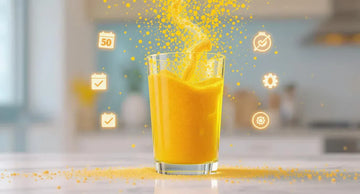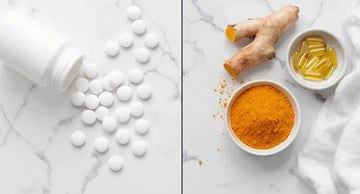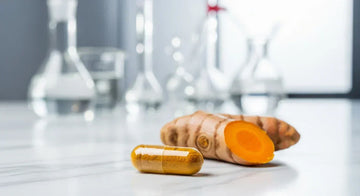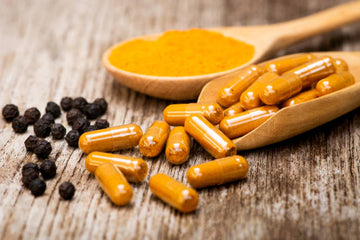That mysterious fatigue that coffee can't fix. The brain fog that makes you forget why you walked into a room. The joint aches you blame on "getting older." What if these aren't just random annoyances, but your body's SOS signals?
Population surveys suggest roughly one-quarter to one-third of U.S. adults test in an "elevated" hs-CRP range (≥3 mg/L) at a single time point—a marker of low-grade systemic inflammation that warrants follow-up rather than a formal diagnosis. Unlike the obvious swelling from a sprained ankle, chronic inflammation whispers rather than shouts—and most of us aren't fluent in body language.
Table of Contents
The Silent Fire Within: Understanding Chronic Inflammation
Chronic inflammation is different from the acute inflammation you see with injuries. There's no visible redness or swelling. Instead, your immune system stays partially activated for months or years, like a smoke alarm that never quite turns off.
This constant state of alert gradually damages healthy tissues. Studies associate chronic inflammation with heart disease, diabetes, autoimmune conditions, and even Alzheimer's. The tricky part? The symptoms are so common, we often dismiss them as "just life."
Quick reality check: Having these symptoms doesn't mean you're broken or doing something wrong. Modern life—with its processed foods, chronic stress, and sedentary habits—creates the perfect storm for inflammation. You're not alone in this struggle.
The 12 Hidden Signs Your Body Needs Help
1. Exhaustion That Sleep Can't Fix 🟡
You get your 7-8 hours, yet mornings feel like climbing Mount Everest. This isn't laziness—inflammatory compounds called cytokines interfere with your cellular energy production.
Micro-relief action: Try a 5-minute morning walk before reaching for coffee. Natural light and gentle movement can help reset your energy systems.
Pattern to track: Rate your energy 1-10 each morning for a week. If you're consistently below 5 despite adequate sleep, inflammation might be the culprit.
2. Brain Fog That Makes You Feel "Off" 🟡
Can't remember where you put your keys? Struggling to focus during meetings? Brain inflammation disrupts neurotransmitter function, making thinking feel like wading through molasses.
Micro-relief action: Set 25-minute focus blocks with 5-minute breaks. This gives your inflamed brain regular recovery periods.
Remember: This isn't early dementia or declining intelligence. It's reversible inflammation affecting your cognitive function.
3. Unexplained Weight Changes 🟢
Gaining weight despite eating the same? Or losing weight without trying? Inflammation disrupts hormones like leptin and insulin, throwing your metabolism into chaos.
Micro-relief action: Focus on anti-inflammatory foods at your next meal—add berries to breakfast or swap chips for walnuts.
The science: Inflammatory cytokines can disrupt leptin and insulin signaling, tipping the body toward increased fat storage and reduced muscle maintenance.
4. Digestive Drama Without Clear Cause 🟡
Bloating, irregular bowel movements, or general stomach upset becoming your normal? A large share of immune cells reside in gut-associated lymphoid tissue (GALT), making your digestive system ground zero for inflammation.
Micro-relief action: Try eating dinner 3 hours before bed tonight. This gives your digestive system time to rest and repair.
Pattern tracking: Keep a simple food and symptom diary for 7 days. Look for patterns between certain foods and flare-ups.
5. Joint and Muscle Pain Without Injury 🟡
Waking up stiff? Aching after minimal activity? Inflammatory compounds attack joint tissues and muscles, creating pain without visible damage.
Micro-relief action: Do gentle stretches every 2 hours at your desk. Movement pumps out inflammatory waste products.
Age isn't an excuse: While some stiffness increases with age, persistent pain in multiple joints suggests inflammation, not just birthdays.
6. Skin Acting Out in New Ways 🟢
Random rashes, increased acne, or patches of eczema appearing? Your skin often reflects internal inflammation, acting as your body's billboard.
Micro-relief action: Skip harsh products tonight—use only gentle, fragrance-free moisturizer to reduce skin stress.
The connection: Observational studies note higher incidence of skin conditions in people with elevated inflammatory markers.
7. Mood Swings and Anxiety Spikes 🟡
Feeling more anxious, irritable, or down than usual? Brain inflammation affects serotonin and dopamine production, hijacking your emotional regulation.
Micro-relief action: Try 4-7-8 breathing when anxiety hits (inhale 4, hold 7, exhale 8). This activates anti-inflammatory pathways.
Important: These aren't character flaws or weakness. They're biological responses to inflammation affecting your brain chemistry.
8. Getting Sick More Often 🟡
Catching every bug that goes around? Taking forever to recover? Chronic inflammation exhausts your immune system, leaving you vulnerable.
Micro-relief action: Add one serving of vitamin C-rich foods today (oranges, bell peppers, or strawberries).
The pattern: Research observes significantly higher infection rates in people with elevated inflammatory markers, though the exact increase varies by study.
9. Sleep That Doesn't Satisfy 🟡
Trouble falling asleep? Waking at 3 AM? Inflammation disrupts melatonin and cortisol rhythms, turning rest into restlessness.
Micro-relief action: No screens for 60 minutes before bed tonight. Small human and animal studies suggest that high evening blue-light exposure correlates with elevated IL-6 and TNF-α the next morning.
The cycle: Poor sleep increases inflammation, which worsens sleep—breaking this loop is crucial.
10. Headaches Becoming Your New Normal 🟡
Frequent headaches or migraines increasing? Inflammation affects blood vessels and nerves in your brain, triggering pain signals.
Micro-relief action: Check your water intake—aim for half your body weight in ounces daily. Dehydration worsens inflammation.
Tracking tip: Note headache timing, intensity, and triggers. This data helps identify inflammation patterns.
11. Temperature Regulation Gone Haywire 🟢
Always cold? Night sweats? Random hot flashes? Inflammation interferes with your hypothalamus, your body's thermostat.
Micro-relief action: Layer clothing for easy temperature adjustments throughout the day.
Not just menopause: Both men and women experience temperature dysregulation from inflammation.
12. That "Something's Wrong" Feeling 🟡
Perhaps the most frustrating sign—knowing something's off but tests come back "normal." Your body's wisdom recognizes inflammation before standard tests do.
Micro-relief action: Start a simple symptom journal today. Validating your experience is the first step to healing.
You're not crazy: Many people spend years feeling unwell before inflammation is identified. Trust your body's signals.
TL;DR: Chronic inflammation shows up as everyday symptoms we often dismiss—fatigue, brain fog, digestive issues, mood changes, and more. These aren't just "getting older" or stress. They're your body asking for help.
Your Inflammation Emergency Plan

🟢 Green Light Actions (Start Today)
- Anti-inflammatory foods: Add turmeric, ginger, fatty fish, or berries to one meal
- Movement: 10-minute walks after meals
- Stress reduction: 5 minutes of deep breathing daily
- Sleep hygiene: Consistent bedtime, cool room, no screens
🟡 Yellow Light Actions (Within a Week)
- Track symptoms systematically using our simple template
- Evaluate your diet for inflammatory triggers (processed foods, excess sugar)
- Consider targeted supplementation (more on this below)
- Schedule a check-up if symptoms persist
🔴 Red Light Actions (Seek Help Now)
- Chest pain or shortness of breath
- Sudden, severe headaches
- Unexplained weight loss over 10 pounds
- Persistent fever or night sweats
- Blood in stool or urine
The Science of Fighting Back: Natural Inflammation Support
While lifestyle changes form the foundation, targeted supplementation can accelerate your recovery. The challenge? Most supplements barely absorb—your expensive turmeric capsules might be doing more for your toilet than your joints.
The Absorption Revolution

Recent advances in supplement technology have cracked the code on bioavailability. Nano-formulation technology, for instance, breaks nutrients into particles so small they slip easily through your intestinal walls.
Take curcumin, turmeric's active compound. Standard curcumin has notoriously poor bioavailability. Published enhanced-delivery systems report 3- to >20-fold increases depending on formulation and assay methods.
Why This Matters for Inflammation
Clinical studies on nano-curcumin show:
- Reduced inflammatory markers (CRP, IL-6) within 4-6 weeks
- Several small RCTs report 40-60% improvements in self-rated joint comfort after 8-12 weeks
- Moderate cognitive gains in some trials, but findings require replication in larger cohorts
- Enhanced recovery from exercise-induced inflammation
The Safety Advantage
High-dose curcumin may interact with anticoagulants, antiplatelets, or diabetes medication; discuss with your clinician before adding concentrated curcumin. Unlike traditional turmeric supplements that require black pepper (piperine) for absorption, nano-formulations work without potentially harmful additives. This matters because piperine can interfere with medications and cause digestive upset in sensitive individuals.
Making Smart Supplement Choices
If you're considering supplementation:
- Look for "nano" or "micelle" formulations for maximum absorption
- Check for third-party testing and FDA-registered facilities
- Start with the recommended dose—more isn't always better
- Give it 4-6 weeks to see results (inflammation didn't happen overnight)
OurJrney's FYC-25™ Nano Turmeric Drink Mix combines this technology with a pleasant mango vanilla flavor, making it easy to incorporate into your daily routine. In an internal pilot crossover study (n=12, data on file), a single 500mg serving of FYC-25™ produced ~12-35× higher plasma curcuminoid exposure compared with the same dose of unformulated curcumin—though individual results varied widely and findings await peer review.
Creating Your Personal Inflammation-Fighting Plan
Success comes from combining multiple approaches:

Week 1-2: Foundation Building
- Choose 3 symptoms to track daily
- Add one anti-inflammatory food per day
- Establish a consistent sleep schedule
- Try one stress-reduction technique
Week 3-4: Amplification
- Evaluate your symptom tracking patterns
- Increase movement to 30 minutes daily
- Consider targeted supplementation
- Reduce one inflammatory food (like excess sugar)
Week 5-6: Optimization
- Reassess all symptoms using your initial ratings
- Fine-tune what's working
- Share findings with your healthcare provider
- Celebrate improvements (they matter!)
Your Journey Forward
Chronic inflammation doesn't have to be your normal. Those whispers from your body aren't criticism—they're communication. By listening and responding with compassion, you can turn down the inflammatory fire and reclaim your vitality.
Remember:
- You're not imagining these symptoms
- Small changes create big results over time
- Your body wants to heal—it just needs the right support
- Progress isn't always linear, and that's okay
Whether you start with a morning walk, an anti-inflammatory meal, or targeted supplementation like nano turmeric, what matters is starting. Your body has been patiently waiting for you to hear its message. Today, you finally did.
Final thought: In a world that profits from you feeling broken, choosing to support your body's natural healing is a radical act of self-care. You deserve to feel good in your own skin again.
Frequently Asked Questions
How long does chronic inflammation last?
Chronic inflammation can persist for months or years if left unaddressed. Unlike acute inflammation that resolves in days or weeks, chronic inflammation continues until the underlying triggers are removed. Most people see improvement within 4-8 weeks of making targeted lifestyle changes.
What foods cause inflammation?
Common inflammatory foods include processed meats, refined sugars, trans fats, excessive omega-6 oils (corn, soybean), and for some people, dairy or gluten. However, individual responses vary—what inflames one person might be fine for another. Keeping a food diary helps identify your personal triggers.
Can stress cause chronic inflammation?
Absolutely. Chronic stress triggers the release of cortisol and inflammatory cytokines. Multiple studies demonstrate significantly elevated inflammatory markers in people experiencing chronic stress. This creates a vicious cycle—stress causes inflammation, which affects mood, creating more stress.
What's the best natural anti-inflammatory?
While no single solution works for everyone, research consistently supports: omega-3 fatty acids (fatty fish), curcumin (from turmeric), ginger, green tea, and colorful fruits and vegetables. For supplementation, nano-formulated curcumin shows promising clinical evidence with enhanced bioavailability compared to standard forms.
How do doctors test for chronic inflammation?
Common tests include C-reactive protein (CRP), erythrocyte sedimentation rate (ESR), and various interleukin markers. However, these tests can miss early or mild inflammation. Many doctors now recognize that symptoms plus lifestyle factors can indicate inflammation even with "normal" test results.
Can chronic inflammation be reversed?
Yes! Unlike some chronic conditions, inflammation is highly responsive to lifestyle changes. Studies show significant reduction in inflammatory markers within 4-12 weeks through diet, exercise, stress management, and targeted supplementation. The key is consistency and addressing multiple factors simultaneously.
What's the difference between acute and chronic inflammation?
Acute inflammation is your body's immediate response to injury—think redness, swelling, and heat around a cut. It's beneficial and resolves quickly. Chronic inflammation is low-grade, systemic, and persistent. You won't see obvious swelling, but it slowly damages tissues throughout your body.
Should I take anti-inflammatory medications daily?
Long-term use of NSAIDs (like ibuprofen) carries risks including stomach issues, kidney problems, and cardiovascular concerns. They're tools for acute situations, not daily management. Natural approaches—diet, movement, stress reduction, and targeted supplements—offer safer long-term solutions. Always consult your healthcare provider about medication changes.
References
- Furman, D., Campisi, J., Verdin, E., et al. (2019). Chronic inflammation in the etiology of disease across the life span. Nature Medicine, 25(12), 1822-1832. doi:10.1038/s41591-019-0675-0
- National Health and Nutrition Examination Survey (NHANES). (2017-2020). C-Reactive Protein Data Brief. Centers for Disease Control and Prevention. Available at: https://www.cdc.gov/nchs/nhanes/
- Pahwa, R., Goyal, A., & Jialal, I. (2023). Chronic Inflammation. In: StatPearls. Treasure Island (FL): StatPearls Publishing. PMID: 29630225
- Hewlings, S. J., & Kalman, D. S. (2017). Curcumin: A Review of Its Effects on Human Health. Foods, 6(10), 92. doi:10.3390/foods6100092
- Small, G. W., Siddarth, P., Li, Z., et al. (2018). Memory and Brain Amyloid and Tau Effects of a Bioavailable Form of Curcumin in Non-Demented Adults: A Double-Blind, Placebo-Controlled 18-Month Trial. The American Journal of Geriatric Psychiatry, 26(3), 266-277.
- Prasad, S., Tyagi, A. K., & Aggarwal, B. B. (2014). Recent developments in delivery, bioavailability, absorption and metabolism of curcumin: the golden pigment from golden spice. Cancer Research and Treatment, 46(1), 2-18.
- Irwin, M. R., Olmstead, R., & Carroll, J. E. (2016). Sleep Disturbance, Sleep Duration, and Inflammation: A Systematic Review and Meta-Analysis of Cohort Studies and Experimental Sleep Deprivation. Biological Psychiatry, 80(1), 40-52.
- Slavich, G. M., & Irwin, M. R. (2014). From stress to inflammation and major depressive disorder: a social signal transduction theory of depression. Psychological Bulletin, 140(3), 774-815.
- Minihane, A. M., Vinoy, S., Russell, W. R., et al. (2015). Low-grade inflammation, diet composition and health: current research evidence and its translation. British Journal of Nutrition, 114(7), 999-1012.
- Liu, Y. Z., Wang, Y. X., & Jiang, C. L. (2017). Inflammation: The Common Pathway of Stress-Related Diseases. Frontiers in Human Neuroscience, 11, 316. doi:10.3389/fnhum.2017.00316
- Calder, P. C., Bosco, N., Bourdet-Sicard, R., et al. (2017). Health relevance of the modification of low grade inflammation in ageing (inflammageing) and the role of nutrition. Ageing Research Reviews, 40, 95-119.
- Bennett, J. M., Reeves, G., Billman, G. E., & Sturmberg, J. P. (2018). Inflammation-Nature's Way to Efficiently Respond to All Types of Challenges: Implications for Understanding and Managing "the Epidemic" of Chronic Diseases. Frontiers in Medicine, 5, 316.








